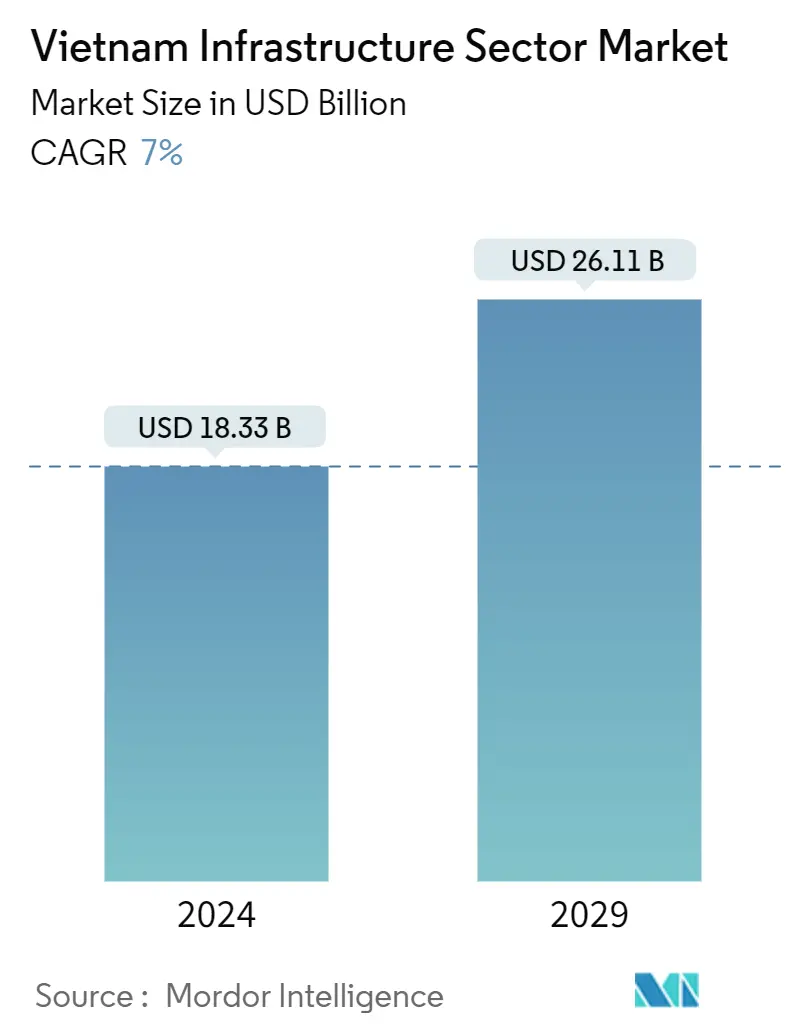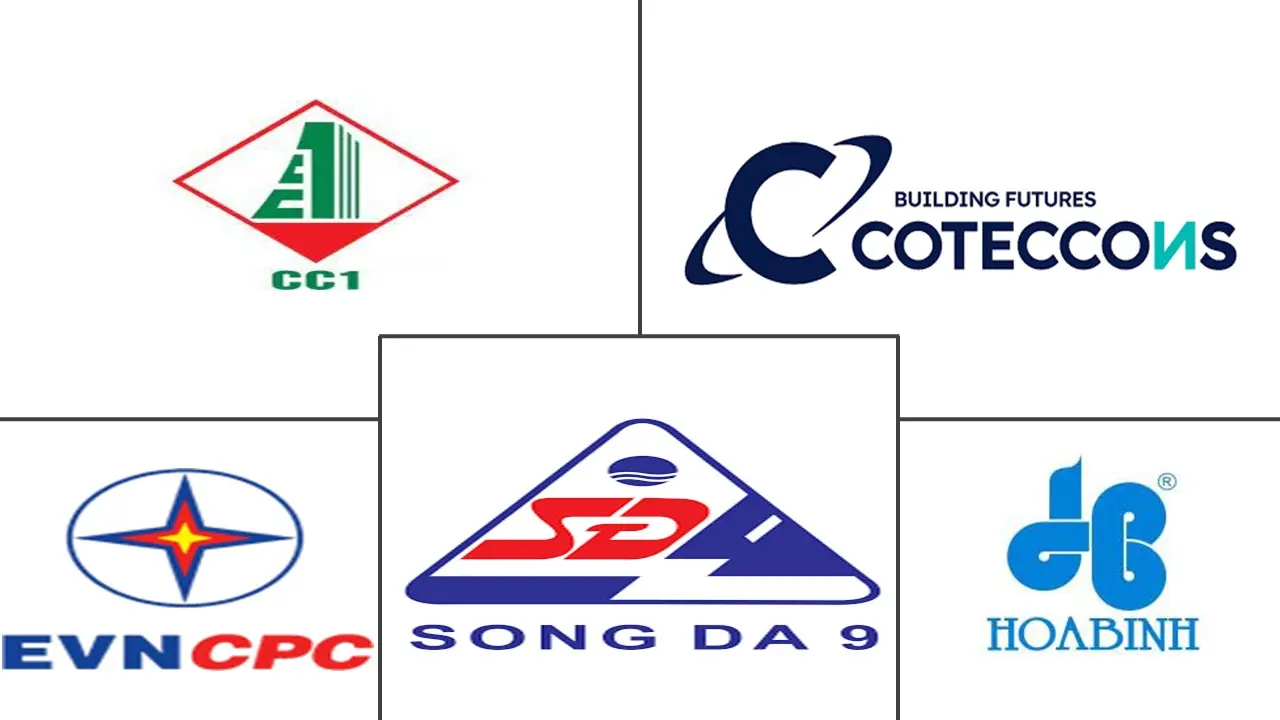Market Size of Vietnam Infrastructure Sector Industry

| Study Period | 2020 - 2029 |
| Base Year For Estimation | 2023 |
| Market Size (2024) | USD 18.33 Billion |
| Market Size (2029) | USD 26.11 Billion |
| CAGR (2024 - 2029) | 7.00 % |
| Market Concentration | Low |
Major Players
*Disclaimer: Major Players sorted in no particular order |
Vietnam Infrastructure Market Analysis
The Vietnam Infrastructure Sector Market size is estimated at USD 18.33 billion in 2024, and is expected to reach USD 26.11 billion by 2029, growing at a CAGR of 7% during the forecast period (2024-2029).
Vietnam presently invests 6% of its GDP on infrastructure, whereas the rest of the region spends an average of 2.3 percent, making Vietnam the ASEAN leader in infrastructure investment. However, analysts believe that there is a disconnect between Vietnam's present infrastructure and its ambitions to be a fast-growing economy. Vietnam Briefing discusses significant infrastructure, present prospects, and government efforts in Vietnam. As per the Global Infrastructure Hub, Vietnam needs on average USD 25-30 billion annually for infrastructure if the country wants to ensure economic growth. However, the national budget can only allow for USD 15-18 billion (at 7 percent of GDP). Therefore, the country has to source the remaining USD 10-15 billion from private investors.
- Government plans to develop further infrastructure, with power and toll roads likely to be the main areas for expansion and quality improvements. Other infrastructure, including ports and railways, will also be developed. It is backed by the government's emphasis on developing the country's rail, road, and energy infrastructure, as well as funding for the building of affordable housing. The government's plan to build 1.4 million units of social housing in Hanoi, Ho Chi Minh City, Da Nang, Can Tho, and Hai Phong Cities by 2030 would also promote forecast-period development in the business. In addition, four state-owned banks put aside VND120 trillion (USD 5 billion) in loans in February 2023 to promote the construction of social housing and worker housing projects.
- Infrastructure has been a central factor in Vietnam's fast-paced economic development. However, economic growth is putting increasing pressure on Vietnam's infrastructure. Freight volumes are expanding rapidly. Road traffic has increased by an astounding 11% annually and the demand for energy is expected to grow by about 10% per year until 2030.
Vietnam Infrastructure Industry Segmentation
Infrastructure is the backbone of domestic and international commerce and industrial and agricultural production. It is the fundamental organizational and physical framework necessary to operate a firm successfully. The infrastructure sector focuses on major infrastructure such as power, roads and bridges, dams, and urban infrastructure.
The market is segmented by the Infrastructure segment (Social Infrastructure, Transportation Infrastructure, Extraction Infrastructure, Manufacturing Infrastructure). The report offers market size and forecast for all the above segments in value (USD).
| By Infrastructure segment | |||||||
| |||||||
| |||||||
| |||||||
|
Vietnam Infrastructure Sector Market Size Summary
The Vietnam infrastructure market is poised for significant growth, driven by the country's strategic focus on enhancing its infrastructure to support rapid economic development. Vietnam leads the ASEAN region in infrastructure investment, dedicating a substantial portion of its GDP to this sector. Despite this, there is a notable gap between the current infrastructure capabilities and the ambitious economic growth targets set by the government. The country's infrastructure development plans are centered around key areas such as power, toll roads, ports, and railways, with substantial government backing and private sector involvement. The government's initiative to construct millions of social housing units in major cities further underscores the commitment to infrastructure expansion. This growth is supported by foreign direct investment, primarily from countries like South Korea, Japan, and Taiwan, which are increasingly channeling funds into Vietnam's infrastructure projects.
The market landscape is characterized by a fragmented structure, with numerous new entrants vying for project opportunities to establish a foothold among the key players. Companies such as Central Power Corporation, Coteccons Construction, and Hoa Binh Construction Group are at the forefront of this expansion. Recent collaborations, like Coteccons' partnership with Microsoft Vietnam, highlight the integration of advanced technologies to enhance construction processes. Additionally, significant projects, such as the development of a large-scale cement plant by Xuan Thien Group, reflect the ongoing investment in infrastructure capabilities. As urbanization continues to rise, particularly in cities like Hanoi and Ho Chi Minh City, the demand for improved connectivity and utility systems is expected to drive further infrastructure development, positioning Vietnam as a burgeoning hub for infrastructure investment in the region.
Vietnam Infrastructure Sector Market Size - Table of Contents
-
1. MARKET DYNAMICS
-
1.1 Market Overview
-
1.2 Market Drivers
-
1.2.1 Increase in FDI in Vietnam boosting the market
-
1.2.2 Government has focused on developing infrastructure to underpin socio-economic development strategies
-
-
1.3 Market Restraints
-
1.3.1 The infrastructure sector in Vietnam is fragmented, which can affect its growth
-
1.3.2 Weak global demand can pose a challenge to the growth of Vietnam's construction industry
-
-
1.4 Market Opportunities
-
1.4.1 With its economy growing strongly, Vietnam's need for infrastructure is increasing across a wide range of sectors
-
-
1.5 Value Chain / Supply Chain Analysis
-
1.6 Porter's Five Force Analysis
-
1.6.1 Threat of New Entrants
-
1.6.2 Bargaining Power of Buyers/Consumers
-
1.6.3 Bargaining Power of Suppliers
-
1.6.4 Threat of Substitute Products
-
1.6.5 Intensity of Competitive Rivalry
-
-
1.7 Market Insights
-
1.7.1 Current Economic and Construction Market Scenario
-
1.7.2 Technological Innovations in the industry
-
1.7.3 Impact of Government Regulations and Initiatives on the Industry
-
1.7.4 Impact of COVID -19 on the market
-
-
-
2. MARKET SEGMENTATION
-
2.1 By Infrastructure segment
-
2.1.1 Social Infrastructure
-
2.1.1.1 Schools
-
2.1.1.2 Hospitals
-
2.1.1.3 Defence
-
2.1.1.4 Others
-
-
2.1.2 Transportation Infrastructure
-
2.1.2.1 Railways
-
2.1.2.2 Roadways
-
2.1.2.3 Airports
-
2.1.2.4 Waterways
-
-
2.1.3 Extraction Infrastructure
-
2.1.3.1 Power Generation
-
2.1.3.2 Electricity Transmission & Disribution
-
2.1.3.3 Water
-
2.1.3.4 Gas
-
2.1.3.5 Telecoms
-
-
2.1.4 Manufacturing Infrastructure
-
2.1.4.1 Metal and Ore Production
-
2.1.4.2 Petroleum Refining
-
2.1.4.3 Chemical Manufacturing
-
2.1.4.4 Industrial Parks and clusters
-
2.1.4.5 Others
-
-
-
Vietnam Infrastructure Sector Market Size FAQs
How big is the Vietnam Infrastructure Sector Market?
The Vietnam Infrastructure Sector Market size is expected to reach USD 18.33 billion in 2024 and grow at a CAGR of 7% to reach USD 26.11 billion by 2029.
What is the current Vietnam Infrastructure Sector Market size?
In 2024, the Vietnam Infrastructure Sector Market size is expected to reach USD 18.33 billion.

